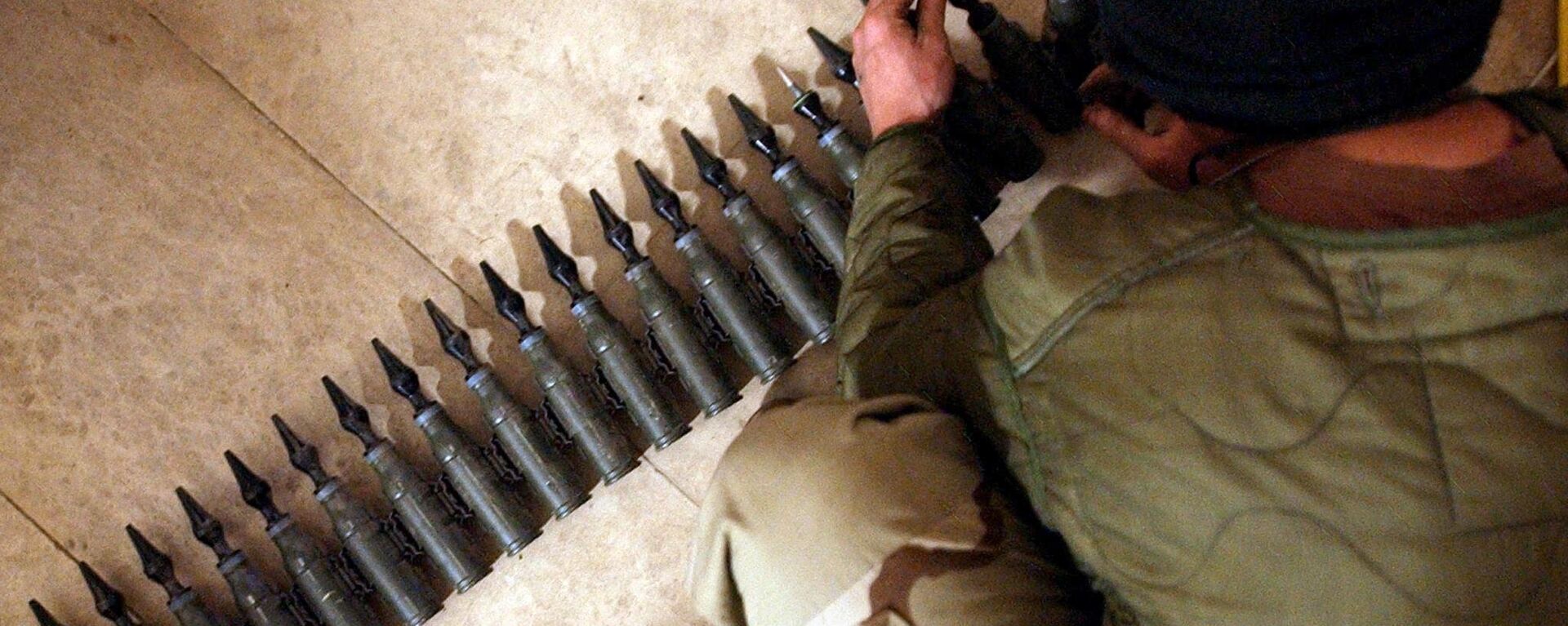https://sputnikglobe.com/20230908/natos-uranium-rounds-are-perfect-storm-of-toxic-pollution-in-breadbasket-ukraine-1113199140.html
NATO's Uranium Rounds are 'Perfect Storm' of Toxic Pollution in 'Breadbasket' Ukraine
NATO's Uranium Rounds are 'Perfect Storm' of Toxic Pollution in 'Breadbasket' Ukraine
Sputnik International
Faced with the failure of Ukraine's summer counter-offensive, the US has taken the dubious step of giving the Kiev regime depleted uranium munitions. Kevin Kamps warned of the multiple risks of the radioactive material.
2023-09-08T13:02+0000
2023-09-08T13:02+0000
2023-09-08T13:02+0000
russia's special operation in ukraine
depleted uranium
ukraine
us
united kingdom (uk)
nato
m1 abrams tank
https://cdn1.img.sputnikglobe.com/img/07e7/06/0d/1111106785_0:160:3072:1888_1920x0_80_0_0_19d45c2235c32d4787c306804421802f.jpg
NATO-supplied depleted uranium (DU) rounds will contaminate Ukraine's 'breadbasket' grain-growing regions with radioactive waste, a nuclear watchdog has warned.This week the US followed the UK in announcing the supply of the controversial armor-piercing rounds for the M1 Abrams tanks it is supplying to the Kiev regime. British Challenger 2 tanks equipped with DU penetrators have already seen action in the Zaporozye region — with at least one meeting a fiery end.Depleted uranium is the left-over material from the enrichment process used to make fuel rods for nuclear power reactors and — at higher levels — elements of nuclear weapons.The concentration of fissile uranium-235 isotope in depleted uranium is about 0.3 percent, 40 percent of the level of element in its unenriched state, but it still emits around 60 percent as much atomic radiation as natural uranium. Most of that is in the form of alpha particles from U-238 and U-234 — the most harmful form of radiation if ingested into the body — with beta particles given out by decay products that form within a few weeks.Watchdog Kevin Kamps told Sputnik that US national security spokesman John Kirby's claim that DU penetrator rods were not radioactive or carcinogenic was simply not true."Depleted uranium munitions are really intended to be armor piercing. They can bust tanks, they can penetrate through concrete," Kamps explained. "It's because they're so dense. Uranium is the densest isotope an element on the periodic table." The harmful nature of DU is well understood, the expert pointed out.He added that DU is often mixed with radioactive waste from nuclear power plants."In both the United States, where this depleted uranium munitions is coming from, but also in other countries, there's a mixing of uranium waste streams off of the enrichment process," Kamps noted. "And what that can often mean is high-level radioactive waste contaminants can be found in uranium waste streams that then get made into depleted uranium."What makes DU even more toxic is its pyrophoric properties — the material ignites on hitting its target, as well as pulverizing into microscopic dust from the near-hypersonic velocity impact. The nuclear waste watchdog said his first thought on hearing the news that the UK and US would give the Kiev regime DU rounds was that "Ukraine is considered the breadbasket of the world, in terms of its grain production." "So now those fields where these battles take place are going to be contaminated with depleted uranium," Kamps said. "The high-level radioactive waste contaminants can include cesium 137, strontium 90. The list goes on and on. And so you really don't want that in your food supply."For more incisive analysis of the top news stories, tune in to our Sputnik News show By Any Means Necessary.
https://sputnikglobe.com/20230907/how-us-media-learned-to-love-depleted-uranium-shells-amid-ukraine-counteroffensive-1113179148.html
ukraine
united kingdom (uk)
Sputnik International
feedback@sputniknews.com
+74956456601
MIA „Rossiya Segodnya“
2023
James Tweedie
https://cdn1.img.sputnikglobe.com/img/07e4/08/1c/1080307270_0:3:397:400_100x100_80_0_0_7777393b9b18802f2e3c5eaa9cbcc612.png
James Tweedie
https://cdn1.img.sputnikglobe.com/img/07e4/08/1c/1080307270_0:3:397:400_100x100_80_0_0_7777393b9b18802f2e3c5eaa9cbcc612.png
News
en_EN
Sputnik International
feedback@sputniknews.com
+74956456601
MIA „Rossiya Segodnya“
Sputnik International
feedback@sputniknews.com
+74956456601
MIA „Rossiya Segodnya“
James Tweedie
https://cdn1.img.sputnikglobe.com/img/07e4/08/1c/1080307270_0:3:397:400_100x100_80_0_0_7777393b9b18802f2e3c5eaa9cbcc612.png
depleted uranium munitions, us supplies du rounds to ukraine, radioactive contamination from depleted uranium rounds
depleted uranium munitions, us supplies du rounds to ukraine, radioactive contamination from depleted uranium rounds
NATO's Uranium Rounds are 'Perfect Storm' of Toxic Pollution in 'Breadbasket' Ukraine
Faced with the failure of Ukraine's summer counteroffensive, the US has taken the dubious step of giving the Kiev regime depleted uranium munitions. Kevin Kamps, a radioactive waste watchdog at Beyond Nuclear, warned of the multiple risks of the radioactive material.
NATO-supplied depleted uranium (DU) rounds will contaminate Ukraine's 'breadbasket' grain-growing regions with radioactive waste, a nuclear watchdog has warned.
This week the US followed the UK in
announcing the supply of the controversial armor-piercing rounds for the M1 Abrams tanks it is supplying to the Kiev regime. British Challenger 2 tanks equipped with DU penetrators have already seen action in the Zaporozye region — with at least one meeting a
fiery end.Depleted uranium is the left-over material from the enrichment process used to make fuel rods for nuclear power reactors and — at higher levels — elements of nuclear weapons.
The concentration of fissile uranium-235 isotope in depleted uranium is about 0.3 percent, 40 percent of the level of element in its unenriched state, but it still emits around 60 percent as much atomic radiation as natural uranium. Most of that is in the form of alpha particles from U-238 and U-234 — the most harmful form of radiation if ingested into the body — with beta particles given out by decay products that form within a few weeks.
Watchdog Kevin Kamps told
Sputnik that US national security spokesman
John Kirby's claim that DU penetrator rods were not radioactive or carcinogenic was simply not true.
"Depleted uranium munitions are really intended to be armor piercing. They can bust tanks, they can penetrate through concrete," Kamps explained. "It's because they're so dense. Uranium is the densest isotope an element on the periodic table."
The harmful nature of DU is well understood, the expert pointed out.
"Uranium in nature is hazardous to begin with," Kamps said. "It's a toxic heavy metal. It is what they say as mildly radioactive, which is kind of a misnomer, radioactivity is hazardous even in mild form."
He added that DU is often mixed with radioactive waste from nuclear power plants.
"In both the United States, where this depleted uranium munitions is coming from, but also in other countries, there's a mixing of uranium waste streams off of the enrichment process," Kamps noted. "And what that can often mean is high-level radioactive waste contaminants can be found in uranium waste streams that then get made into depleted uranium."
What makes DU even more toxic is its pyrophoric properties — the material ignites on hitting its target, as well as pulverizing into microscopic dust from the near-hypersonic velocity impact.
"It's kind of the perfect storm of hazard. You've got toxic heavy metal, you've got radioactivity that can be contaminated with much higher level radioactivity from high-level radioactive waste," Kamps stressed. "And then it turns into a fine dust that you can breathe in, that blows on the wind, that settles on the water and flows downstream and downwind and harms people and other living beings all along the way."

7 September 2023, 15:58 GMT
The nuclear waste watchdog said his first thought on hearing the news that the UK and US would give the Kiev regime DU rounds was that "Ukraine is considered the breadbasket of the world, in terms of its grain production."
"So now those fields where these battles take place are going to be contaminated with depleted uranium," Kamps said. "The high-level radioactive waste contaminants can include cesium 137, strontium 90. The list goes on and on. And so you really don't want that in your food supply."
For more incisive analysis of the top news stories, tune in to our Sputnik News show By Any Means Necessary. 



